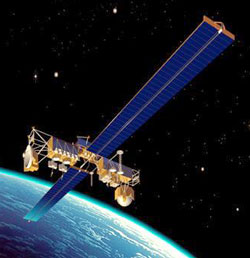 |
Tuesday, November 27, 2007
National Geophysical Data Center (NGDC) Develops New Daytona Beach, FL Tsunami Inundation Digital Elevation Model (DEM)
The National Geophysical Data Center (NGDC) has developed a high-resolution DEM for the Pacific Marine Environmental Laboratory (PMEL) covering the coastal region centered on Daytona Beach, Florida from New Smyrna Beach in the south to Palm Coast in the north. This combined bathymetric-topographic DEM includes the communities of Flagler Beach, Ormond Beach, and Daytona Beach Shores. Development of coastal DEMs is part of an on-going collaboration across NOAA to support the tsunami forecast and warning system being transitioned by PMEL to the Tsunami Warning Centers. The new DEM covers an area of approximately one degree square and has a grid spacing of 1/3 arc-second (~10 m). NGDC built the DEM from the best available digital data obtained from U.S. federal, state, and local agencies, and one private company, and will increase the accuracy with which NOAA's tsunami modeling efforts to forecast inundation in the area.
Significance: Although infrequent, tsunami waves have caused considerable damage and loss of life in U.S. coastal areas. The NOAA/NGDC development of coastal digital elevation models is an integral part of NOAA's effort to forecast tsunamis and deliver accurate and timely warnings. These DEMs are also potentially useful for other inundation and coastal mapping needs. The DEMs and other tsunami data archived by NGDC provide information essential for coastal hazard assessment and research related to past hazardous events for monitoring and mitigating the socio-economic impact of coastal hazards.
Outcome: This activity supports the general goal to improve our environmental and marine infrastructure and to develop a more robust Global Earth Observation System of Systems (GEOSS).
For further details, please contact Lisa Taylor of the National Oceanic and Atmospheric Administration (NOAA) at Lisa.A.Taylor@noaa.gov or (303) 497-6767.
NOAA/NGDC - News Release
The National Geophysical Data Center (NGDC) has developed a high-resolution DEM for the Pacific Marine Environmental Laboratory (PMEL) covering the coastal region centered on Daytona Beach, Florida from New Smyrna Beach in the south to Palm Coast in the north. This combined bathymetric-topographic DEM includes the communities of Flagler Beach, Ormond Beach, and Daytona Beach Shores. Development of coastal DEMs is part of an on-going collaboration across NOAA to support the tsunami forecast and warning system being transitioned by PMEL to the Tsunami Warning Centers. The new DEM covers an area of approximately one degree square and has a grid spacing of 1/3 arc-second (~10 m). NGDC built the DEM from the best available digital data obtained from U.S. federal, state, and local agencies, and one private company, and will increase the accuracy with which NOAA's tsunami modeling efforts to forecast inundation in the area.
Significance: Although infrequent, tsunami waves have caused considerable damage and loss of life in U.S. coastal areas. The NOAA/NGDC development of coastal digital elevation models is an integral part of NOAA's effort to forecast tsunamis and deliver accurate and timely warnings. These DEMs are also potentially useful for other inundation and coastal mapping needs. The DEMs and other tsunami data archived by NGDC provide information essential for coastal hazard assessment and research related to past hazardous events for monitoring and mitigating the socio-economic impact of coastal hazards.
Outcome: This activity supports the general goal to improve our environmental and marine infrastructure and to develop a more robust Global Earth Observation System of Systems (GEOSS).
For further details, please contact Lisa Taylor of the National Oceanic and Atmospheric Administration (NOAA) at Lisa.A.Taylor@noaa.gov or (303) 497-6767.
NOAA/NGDC - News Release

